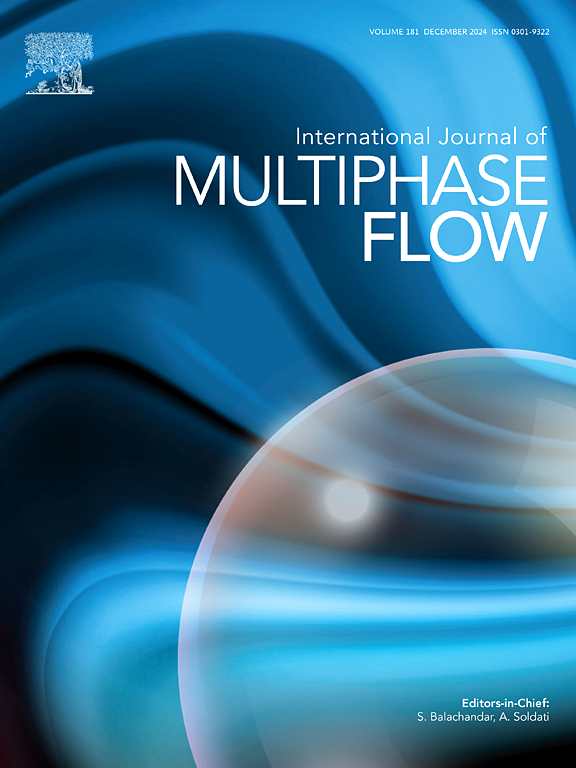Interface coupling effects on Rayleigh–Taylor and Faraday instabilities in granular suspensions under oscillatory forcing
IF 3.8
2区 工程技术
Q1 MECHANICS
International Journal of Multiphase Flow
Pub Date : 2025-09-20
DOI:10.1016/j.ijmultiphaseflow.2025.105448
引用次数: 0
Abstract
This study investigates how interface coupling effect affects the sedimentation dynamics of finite-thickness granular suspensions under both constant gravity and oscillatory accelerations. Through Euler–Lagrange simulations, we examine the evolution of Rayleigh–Taylor instability (RTI) at the lower interface. Under constant gravity, reducing suspension thickness, thereby intensifying interface coupling effects, suppresses the growth rate of RTI while increasing the dominant wavenumber. Under oscillatory acceleration, two competing mechanisms emerge: while reduced thickness inherently inhibits RTI growth in the absence of oscillation, it simultaneously weakens oscillations’ stabilizing effect. This competition leads to a reversal of behavior observed under constant gravity, wherein high-amplitude oscillations cause thinner suspensions to exhibit more rapid instability growth than thicker layers. Linear stability analysis captures this reversal and matches numerical results well. It further demonstrates that, due to the attenuated effect of oscillation-induced stabilization, increasing oscillation amplitude inevitably induces growth rate inversions from high to low wavenumbers in thinner suspensions; nevertheless, these suspensions consistently maintain higher dominant wavenumbers. Additionally, granular suspensions can also develop Faraday instability (FI) at the upper interface, with its dominant wavenumbers increasing with oscillation frequency, though this increase diminishes particle resolution at interfaces, leading to reduced consistency between theoretical and numerical results.

振荡强迫下颗粒状悬浮液中瑞利-泰勒和法拉第不稳定性的界面耦合效应
本文研究了在恒定重力和振荡加速度作用下,界面耦合效应对有限厚度颗粒悬浮液沉降动力学的影响。通过欧拉-拉格朗日模拟,我们研究了下界面的瑞利-泰勒不稳定性(RTI)的演化。在恒重力条件下,减小悬浮厚度,从而增强界面耦合效应,抑制RTI的生长速率,同时增加主导波数。在振荡加速度下,出现了两种相互竞争的机制:在没有振荡的情况下,厚度的减小抑制了RTI的生长,同时减弱了振荡的稳定作用。这种竞争导致恒定重力下观察到的行为逆转,其中高振幅振荡导致较薄的悬浮液比较厚的悬浮液表现出更快的不稳定生长。线性稳定性分析捕捉到了这种反转,并与数值结果很好地吻合。进一步表明,由于振荡诱导稳定化的衰减效应,振荡振幅的增加不可避免地导致较薄悬浮液中从高波数到低波数的生长速率反转;然而,这些悬浮液始终保持较高的优势波数。此外,颗粒状悬浮液也会在上部界面处产生法拉第不稳定性(FI),其主导波数随着振荡频率的增加而增加,尽管这种增加会降低界面处的颗粒分辨率,导致理论和数值结果之间的一致性降低。
本文章由计算机程序翻译,如有差异,请以英文原文为准。
求助全文
约1分钟内获得全文
求助全文
来源期刊
CiteScore
7.30
自引率
10.50%
发文量
244
审稿时长
4 months
期刊介绍:
The International Journal of Multiphase Flow publishes analytical, numerical and experimental articles of lasting interest. The scope of the journal includes all aspects of mass, momentum and energy exchange phenomena among different phases such as occur in disperse flows, gas–liquid and liquid–liquid flows, flows in porous media, boiling, granular flows and others.
The journal publishes full papers, brief communications and conference announcements.

 求助内容:
求助内容: 应助结果提醒方式:
应助结果提醒方式:


